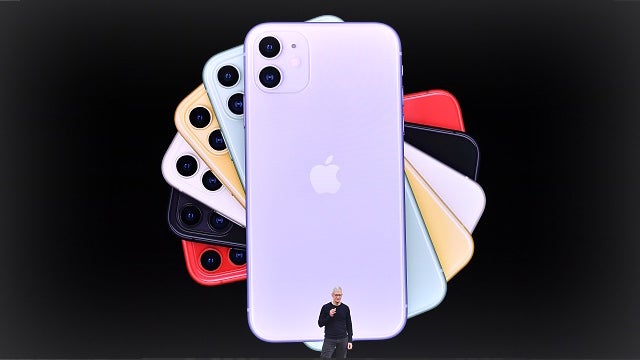RUSH: I have a decent amount of time here to try to use this example of just outright brilliant capitalism using Apple’s new iPhones that were released on Tuesday as the example. Again, it’s not a pitch for Apple. Please don’t anybody misunderstand here. It’s just this happens to be an extremely good teachable moment.
And it’s rooted in the fact that media that covers Apple hates them, like media hates conservatism, media hates the Republicans, for whatever reason, even though Apple is a great liberal, culturally liberal company, they despise ’em. Some do. A large number.


So, in 2017 Apple introduces the iPhone X, and it has technology in it that is way beyond anything anybody else has. It’s got facial recognition. It’s got an advanced screen. It has two cameras with all kinds of computational software photography, editing abilities. It’s state-of-the-art. There’s nothing like it. It’s got a 5.8-inch screen, and it has no bezels to speak of.
It’s a totally revolutionary phone, and it costs a thousand dollars. And that led the media to just ripping Apple to shreds. Apple’s lost touch, Apple doesn’t care about market share, Apple doesn’t realize it’s not making a phone for — even though Apple had all kinds of phones that were much cheaper, they were older, but if you couldn’t afford a thousand, there were other things for you.
So, the media ripped ’em, said Apple wasn’t gonna sell any of them. It turned out to be the hottest-selling phone of the year in 2017. In 2018, Apple introduced the next upgrades and added a six-and-a-half-inch screen to what was a 5.8-inch screen. Same facial recognition, same screen technology, upgraded faster processor, again a state-of-the-art phone, and the prices remained the same.
The iPhone XS, still a thousand bucks, and the iPhone XS plus or Max was $1,100, and maxed out with storage, it was $1,500. And the media went bonkers again. Apple’s lost it. Apple doesn’t care. Apple’s greedy. Apple’s selling this stuff at prices — nobody’s gonna pay a thousand dollars, nobody’s gonna buy these phones.
And they sold in record quantities again. Well, not record quantities, but they sold at an average sale price that Apple made money by selling fewer phones. Okay. So now we come to this year, and Apple introduces three new phones. Now, the one that I want to talk about is the new iPhone 11, because last year, in addition to the XS and XS Max, they introduced something called the XR.
It was the cheaper phone. It only had one camera. It had half-assed Wi-Fi speeds, I mean, half-assed LTE. It had an LCD screen. Nothing technological advanced about it except the screen was 6.1 inches and it was priced at $750. Media loved it, media said Apple’s finally recognizing the reality for people, they can’t afford a thousand dollars, they can’t afford $1,500, $750, and it was still too expensive but at least Apple was said to be doing the right thing.
Now this year, three new phones, iPhone 11, 11 Pro, 11 Pro Max. What I want to talk about is the iPhone 11. It is the upgrade to the XR. Two years ago they introduced the iPhone X, thousand dollars, state-of-the-art, nothing like it. This year the iPhone 11 costs less than $700, and it’s a better phone than the iPhone X at a thousand dollars two years ago.
It has two cameras. It has better battery life. It has a faster processor. In other words, this year Apple is introducing a phone that is miles ahead of the first thousand-dollar phone two years ago, and this phone is less than $700. How do they do it? It’s simple. All of those expensive phones, people bought ’em. The early adopters went out and bought ’em in droves, and that financed the ability to manufacture state-of-the-art tech at massive Apple scale.
So, maybe two years ago you couldn’t afford the iPhone X state-of-the-art, but two years later you could afford a much better phone for $300 less. And it’s all because Apple sold those expensive phones knowing they were gonna have buyers for ’em, which essentially paid for — the early adopters always do — this is the lesson. The first revolutionary TV – I remember when I first bought my Betamax. It recorded for one hour, $1,200.
Two years later a VHS video recorder that records for four hours could be bought for $250. So while they couldn’t sell the iPhone X at $600 or seven to make a profit because it was revolutionary and they couldn’t mass produce enough parts to sell it at that price, in two years people can buy an even better phone, markedly so, for $300 less. And that’s how it works. Early adopters pay the freight so that eventually all this maximum technological advancement finds its way to the masses.
BREAK TRANSCRIPT
RUSH: So, the point is two years ago, Apple introduces a state-of-the-art phone that many people can’t afford. Two years later, they introduce a phone that is even better than that that costs $300 less. It only took ’em two years for the early adopters to purchase the highfalutin stuff in enough quantity to bring down the cost of all the components produced at massive, Apple-type scale. So, it’s not that Apple was denying anybody anything.
They just couldn’t make a profit selling a state-of-the-art piece of tech at 700 bucks, but they can now. That’s how capitalism works. The market works. Markets work. People wanted that phone, but couldn’t buy it. Nobody — very few people — are gonna spend a thousand dollars on a cell phone. It’s a phone, for crying out loud! Even though it’s much else, it’s a phone. This phone’s actually $650 now versus $1,000, and it’s almost twice the phone that people couldn’t afford two years ago.
Related Links


